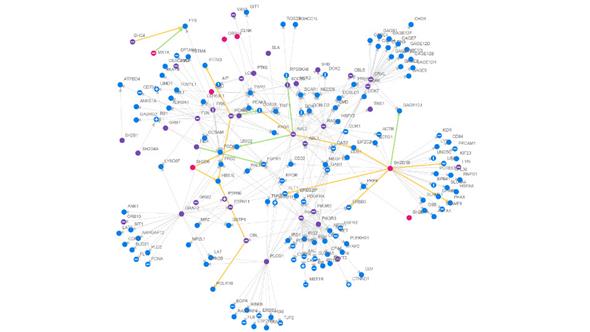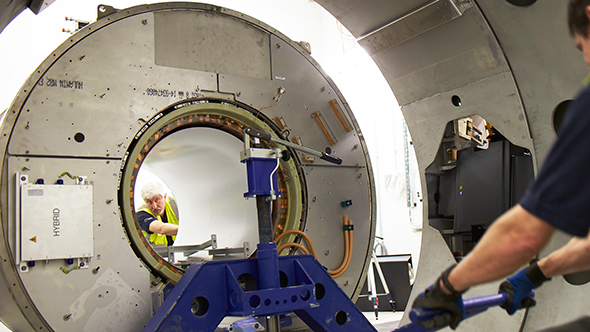.jpg?sfvrsn=369a7969_4)
Big Data cloud embed (image: Dr Bissan Al-Lazikani et al)
I recently attended a talk by Dr Angela Kukula, Director of Enterprise here at The Institute of Cancer Research, London, which rather neatly set out some of the most exciting ways in which we’re seeking to make progress against cancer. She was speaking at an Inside Government policy forum on the future of cancer research and the Cancer Drugs Fund.
Dr Kukula started by emphasising the major changes there have been in cancer treatment in recent years — with the move from broad-action chemotherapy to precision medicines targeted at particular molecular defects in cancer cells.
She then outlined the challenges that remain even with these treatments — explaining that cancers evolve in a Darwinian manner, leading to drug resistance, and warning that new approaches were needed to counter this so-called ‘survival of the nastiest’.
She picked out seven examples of innovative and exciting ways to tackle cancer evolution and drug resistance.

1. Predicting tumour evolution
If we can fully understand the processes involved in cancer evolution, we can try to find ways to block the disease’s escape pathways. Through genomic sequencing, and techniques such as liquid biopsies, we can detect which mutations are driving a cancer and track how it is progressing and responding to treatment, providing early evidence for whether a drug is working or if treatment needs to be adjusted.

2. Drug combinations
Using scientifically selected combinations of drugs that target several different signalling pathways at once has the potential to combat the genetic diversity of cancers and their propensity to adapt and evolve. It’s an approach which has been successfully applied to create drug combinations to tackle antibiotic resistance and treat rapidly evolving diseases such as HIV. Now it is being increasingly applied to cancer.

3. Network drugs
We are interested in creating new ‘network’ drugs which tackle more than one cellular signalling pathway that’s been hijacked in cancer at once. Because they act on several targets simultaneously, they can hit cancer harder than drugs targeted to just one protein.

4. Targeting non-oncogene addiction
We are looking into approaches which target characteristics of cancer cells rather than directly hitting the oncogenes, the genetic changes that actually caused the cancer. Cancer cells can, for instance, become dependent on processes such as making new proteins or ‘chaperoning’ to make sure these proteins fold correctly. Taking the indirect route to attacking cancer could bring effective new treatments.

A white blood cell of the immune system (photo: Wellcome Images)
5. Immunotherapy
The harnessing of the body’s own immune system to target tumours is an area of research generating real excitement at the moment. Dr Kukula gave an overview of some of the latest developments — from immune checkpoint drugs like PD-1 receptor inhibitors to CAR-T cell therapy, where the patient’s own immune cells are taken from their blood and genetically engineered before being given back to the patients.
-midarticle.jpg?sfvrsn=9ca74669_1)
Big Data cloud (image: Dr Bissan Al-Lazikani et al)
6. Using Big Data to identify targets
Analysis of Big Data has been changing the way that we find and exploit potential drug targets. Studies from the ICR have found that at least 10% of cancer proteins are technically druggable but have not yet been properly explored. Several of these potential drug targets are now being tackled by academia and industry.

The heavy magnet for the MR-Linac is carefully manoeuvred (image courtesy of Elekta)
7. Advances in radiotherapy
The biggest breakthroughs in research and treatment certainly aren’t all happening in the field of new drugs: advances in radiotherapy are also having great benefits for patients. Angela spoke about the MR Linac, a new type of radiotherapy machine which is being installed at the ICR and The Royal Marsden, which combines an MRI scanner and an ultramodern radiotherapy system called a linear accelerator. This allows us to precisely locate tumours and shape beams of radiation to their dimensions with extreme precision, even when tumours are moving, for example, as a patient breathes.
All of these areas of research are highly exciting and could yield the next big steps forward in cancer treatment. But Dr Kukula stressed that to make sure patients benefit, it’s essential to have a structured programme for taking research from the laboratory to patients.
She finished her talk by explaining how the ICR translates the findings from our labs into the clinic by partnering with industry and through our close relationship with The Royal Marsden.
It’s this combination of innovative research and a rigorous focus on delivering impact for patients that looks set to continue to deliver exciting progress against cancer.
comments powered by